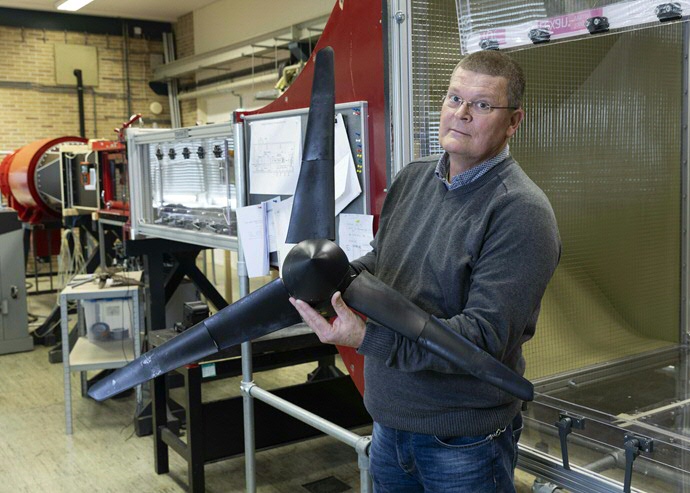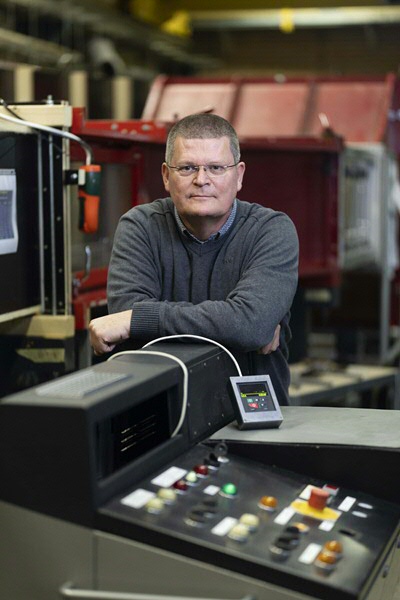From paperclip to patent

How is it possible that an albatross doesn’t crash and die when it lands? And how come its large wings don’t break due to air resistance? That is what you would expect, according to the laws of aerodynamics. However, Professor Eize Stamhuis has discovered that albatrosses land safely by making wiggly wing movements. What is more, he sees a possible application of this oscillation technique to make the blades of wind turbines more efficient. To protect his intellectual property (IP), he has applied for a patent. He has also attracted interest from industries working on aerodynamics. So, how does he work?
Text: Gert Gritter, Communication UG; photos Jeroen van Kooten
His office in the ultramodern Linnaeusborg building looks like a cabinet of curiosities. On his table, for instance, are various 3D prints of a globe-shaped trunkfish. On the wall hangs a plaster cast of an ichthyosaur, a prehistoric fish-like animal. There are models of penguins. The gills of a paddlefish (from the former Emmen Zoo) float in a pot of formalin. But Stamhuis is not really a collector. He uses these models to develop, apply and market his innovations. They all serve a scientific purpose, inspired by what nature thought up. The wiggly movements that albatrosses, petrels and other large sea birds make with the ends of their wings are a good example. The wiggles enable the birds to generate more lift at low speed, especially before landing. For smaller birds, such as crows, it is enough to simply flap their entire wings. Stamhuis: ‘In my research group, we immediately had a gut feeling that this was worth looking into. It was exciting!’
Innovation Albatrozz
Stamhuis and his group are involved in the University’s Energy and Sustainability Research Institute Groningen (ESRIG). The idea of a biomimetic wind turbine with oscillating blades, christened ‘Innovation Albatrozz’, has to a large extent been patented. It has also received a € 40,000 subsidy from the Netherlands Organisation for Scientific Research (NWO) to prepare for market introduction. Windmill producers have shown an interest. The albatross technique has the great advantage that it works at low wind speeds, which are common in the Netherlands. Thanks to this new technique, the efficiency of wind turbines is expected to increase by no less than 25%. This could mean that fewer turbines would be needed to generate the same amount of electricity. This is quite important now that the unease about windmills and the resistance to their deployment are growing.
IP awareness
Stamhuis: ‘If you have a cool idea like Innovation Albatrozz, it’s hugely satisfying if you can make it work in practice. And if on top of that, you’re also making money, then that’s wonderful. You’re not likely to get rich—though miracles do happen now and then—but it’s nice if some money flows back into your research. But bear in mind that if you see possible commercial applications for your idea, you need to do some things differently. Many researchers shy away from this, thinking: I don’t want to get involved in financial stuff. But that’s why the UG has specialists at the IP & Business Development Team of Northern Knowledge and the ABJZ legal department. You really must seek the help of people who can think commercially and legally. And you will have a much stronger position in negotiations if you are supported by lawyers with experience. You don’t want the other party to regard you as just another egghead from Groningen...’
Timing and discipline
‘Timing and discipline are very important. If you think that you have an exciting new idea, you must keep it to yourself at first. Don’t publish anything about it, because then your newly-found knowledge will be up for grabs. It’s unnatural for us scientists to keep our mouths shut. We are always keen to share ideas and get feedback. But I have learned from my mistakes. Once, I talked enthusiastically about a discovery at a scientific conference, and I later found out that some Americans had gone and patented my idea. It was a painful lesson. Now I have a gap of a few months in my list of publications, keeping articles on hold so as not to reveal anything about an invention that we want to patent.’

‘An animal is a brilliant piece of technology’
As a researcher in Marine Zoology and Biomimetics, he studies nature, especially the movement of animals through air and water, striving to apply discoveries to technology. ‘In nature, you find many examples of smart mechanics that, over millions of years, have evolved into the most efficient form. Animals are primarily interesting to me as brilliant pieces of technology, sometimes with unusual technical characteristics. I’m curious about the mechanism behind it all. What is the function? What benefits does it provide? And above all: can we apply the idea, for example to solve contemporary problems?’
Underwater robots
He is interested in the trunkfish, mentioned above, because it can turn on its axis without moving and can manoeuvre very stably. This property might be useful in underwater robots. He is also looking at the paddlefish, because it can filter zooplankton from the water, using its gills. Its filter never gets clogged, and maybe this suggests a solution for a common problem of filters used in industrial production processes. Ichthyosaurs and penguins are interesting because of their aerodynamic and hydrodynamic properties. Eize Stamhuis is also looking into adjusting the propellers of boats based on the movements of a penguin’s flippers.
Chewing gum and Scotch tape
Lego, Meccano, cardboard, paper clips, clothes pegs, Scotch tape, glass head pins, pipe cleaners. All over Stamhuis’s office, you can find show models made of the strangest materials. ‘I want to test my concepts by first building them to scale, so that I know: okay, the principle works. To me, scientific research = tinkering + mucking around. I am the “chewing gum and sticky tape” kind of researcher. My children used to get angry with me if I took their toys to the office to use them in my research.’ And Eize Stamhuis also applies his Do-It-Yourself approach to large constructions. Using stuff he bought in a hardware store and working with colleagues, he developed two enormous streaming tanks with measuring equipment in the basement of the Linnaeusborg building, to conduct research into water flows. You can also often find him in the wind tunnel of the KVI Centre for Advanced Radiation Technology.
More information
More news
-
15 September 2025
Successful visit to the UG by Rector of Institut Teknologi Bandung
